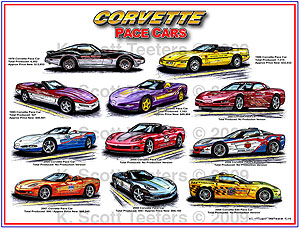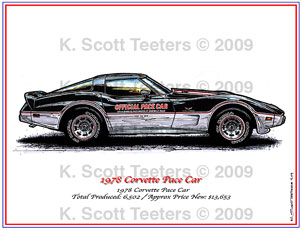Dateline: 9.19.11
From the Archives of The Illustrated Corvette Series
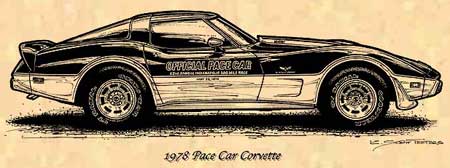 The Corvette’s tough-guy legend is founded on racing and performance. By the mid-to-late ‘70s, Corvette high-performance and racing efforts were in the pits. Power was down, weight was up, and Porsches were eating the Corvette’s lunch at the race track. The announcement that the 25th anniversary Corvette would also be the pace car at the ’78 Indy 500, looked like the highlight of the decade for Corvette fans. But controversy was in the mix right from the beginning.
The Corvette’s tough-guy legend is founded on racing and performance. By the mid-to-late ‘70s, Corvette high-performance and racing efforts were in the pits. Power was down, weight was up, and Porsches were eating the Corvette’s lunch at the race track. The announcement that the 25th anniversary Corvette would also be the pace car at the ’78 Indy 500, looked like the highlight of the decade for Corvette fans. But controversy was in the mix right from the beginning.
Initially, it looked like a triple-play for Chevrolet. First, the ’78 Corvette received a sleek new fastback roof that completed the overall redesign started in ’73 with the soft bumper covers. Second, all Corvettes wore the 25th Anniversary badges. And third, three special Corvettes would serve as the pace cars at the ’78 Indy 500, and replicas would be available. Then the details set in.
The initial proposal was that there would be 300 pace car replicas, the same number as the ’53 production run. The car would have a two-tone silver paint (for the silver anniversary), red pin striping, and special Goodyear tires with “CORVETTE” sidewall lettering. Then the plan was to make 2,500 replicas, 100 for each year of production. But there were 6,200 dealers that all wanted at least one replica, so production went up to 6,502 units. Then two key elements were changed. The special “CORVETTE” tires were deemed too expensive, and paint was changed to sliver and black.
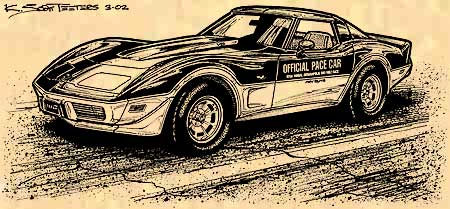 Then there was the price issue. The RPO 1YZ8778 package cost $4,302, on top of the $9,351 base price – a 46-percent premium! Here’s what came with the option. The exterior had special two-tone paint and pin striping, unique front and rear spoilers, glass roof panels, sport mirrors, and red pin stripped aluminum wheels on P225/60R15 tires. The interior came with power windows and door locks, tilt-telescopic steering column, convenience group, silver thin-shell seats, AM/FM with a CB radio or an 8-track tape player, dual rear speakers, and a power antenna. The $525 L82 engine rated at 220-hp was not part of the package.
Then there was the price issue. The RPO 1YZ8778 package cost $4,302, on top of the $9,351 base price – a 46-percent premium! Here’s what came with the option. The exterior had special two-tone paint and pin striping, unique front and rear spoilers, glass roof panels, sport mirrors, and red pin stripped aluminum wheels on P225/60R15 tires. The interior came with power windows and door locks, tilt-telescopic steering column, convenience group, silver thin-shell seats, AM/FM with a CB radio or an 8-track tape player, dual rear speakers, and a power antenna. The $525 L82 engine rated at 220-hp was not part of the package.
The controversy started right on the showroom floor. For a premium collectible,” quality was not good. On many of the cars, fender seams and slight bubbles were clearly visible. The black upper body paint only made the defects look worse. Then there were the opportunistic dealers who tacked on surcharges that bumped the price up to between $15,000 to $22,000. One dealer was asking $75,000 for his replica. Then, there were individuals making replicas of the pace car replica, asking full price for their creations! All that, for a car with no more “grunt” than a regular Corvette.
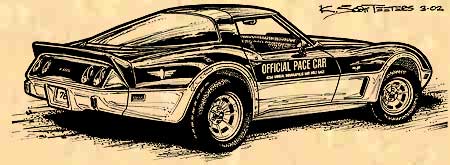 Meanwhile, at the 62nd Indy 500 race on May 28, 1978, Jim Rathmann drove one of three Pace Car Corvettes to start the race. One of the pace cars was given to Al Unser for winning the race, another was sent to the Detroit Museum, and the last pace car was sold through a Chevy dealer to a professional baseball trainer. The ‘78 Pace Car Corvettes were the first pace cars to work the race with a stock drivetrain. All previous pace cars had serious performance enhancements. But the production Corvette, even though it was down on power from its earlier days, was up to the job!
Meanwhile, at the 62nd Indy 500 race on May 28, 1978, Jim Rathmann drove one of three Pace Car Corvettes to start the race. One of the pace cars was given to Al Unser for winning the race, another was sent to the Detroit Museum, and the last pace car was sold through a Chevy dealer to a professional baseball trainer. The ‘78 Pace Car Corvettes were the first pace cars to work the race with a stock drivetrain. All previous pace cars had serious performance enhancements. But the production Corvette, even though it was down on power from its earlier days, was up to the job!
In today’s market, ’78 Pace Car Corvettes can be purchased for between $7,000 to $30,000. Although the ’78 Pace Car always was a very nice car, between the high volume and low performance, the car’s value has yet to take off – over 30-years later. But imagine a ’69 427/435 Corvette Pace Car instead of the ’69 Camaro. Pace Car. Now you’re talking! – Scott

PS – The Illustrated Corvette Series has covered all of the Corvette Indy 500 Pace Cars from 1978 to 2008. You can check out the 1978 Indy 500 Pace Car HERE.
Here’s the BEST way to keep up with K. Scott Teeters’ Corvette blog!


